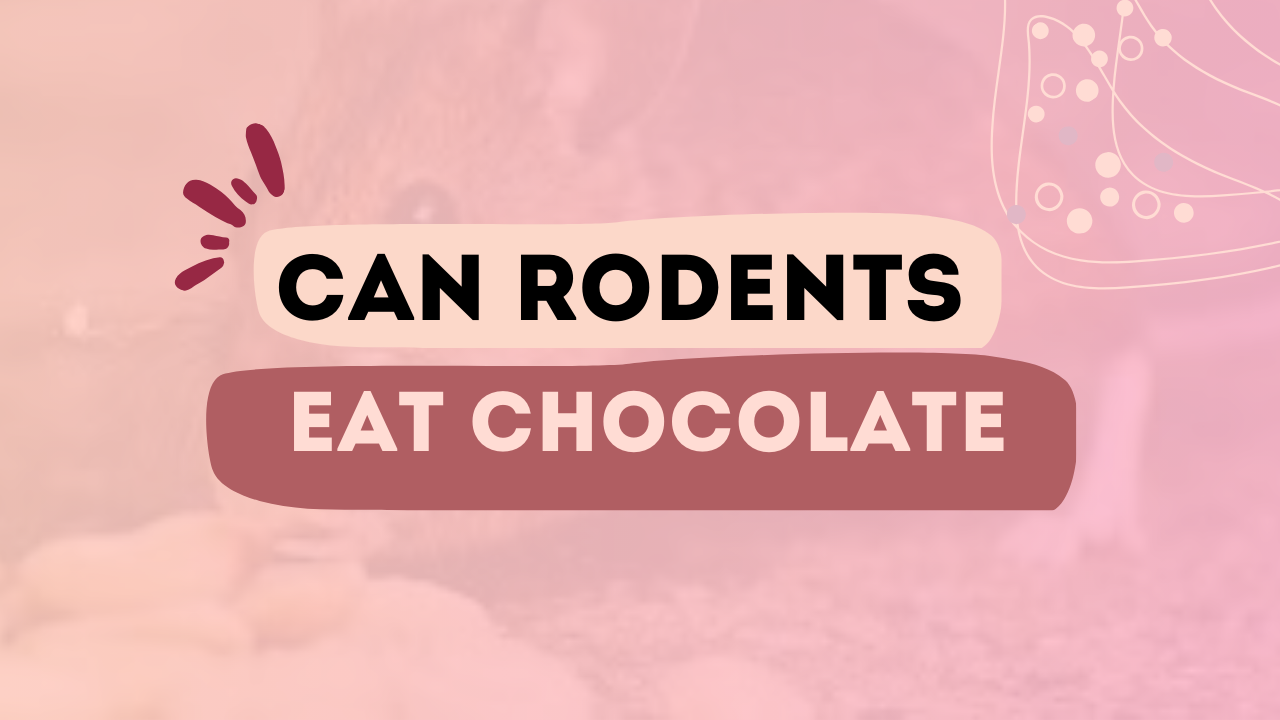We all know how tempting chocolate is, right? Whether it’s a crunchy bar or a velvety truffle, the sweet treat is hard to resist for us humans. But, have you ever wondered if it’s safe to share that delicious chocolate with your pet rodent? I mean, they’re cute, they nibble on everything, so why not? But hold your horses! It turns out that while it might seem harmless to sneak a piece of chocolate to your furry little friend, doing so could be a big mistake. In fact, giving chocolate to rodents could lead to serious health issues. So, let’s dive into the science and figure out exactly why chocolate is a no-go for rodents!
Why Can’t Rodents Eat Chocolate?
You might be thinking, “But wait, how harmful can a little piece of chocolate be?” Well, the answer lies in the way chocolate affects small animals like hamsters, guinea pigs, mice, and rats. Chocolate contains substances called theobromine and caffeine, both of which are toxic to many animals, especially small rodents. While humans can metabolize these chemicals without a problem, rodents—due to their tiny size and faster metabolism—are much more sensitive to these compounds.
Theobromine: The Real Culprit
Theobromine is the main reason why chocolate is so dangerous for rodents. It’s a stimulant found naturally in cocoa beans and is what gives chocolate its energizing effects. In humans, theobromine is mostly harmless because our bodies process it at a slower rate, but rodents metabolize it much quicker. When a rodent consumes chocolate, theobromine accumulates in their system much faster, leading to toxicity. The effects can range from mild to severe, depending on how much chocolate the rodent eats.
Symptoms of Chocolate Poisoning in Rodents
If you ever do accidentally give your rodent some chocolate (we’ve all been there!), there are several symptoms to watch out for. Mild signs of chocolate poisoning include restlessness, rapid breathing, and an increase in heart rate. If the amount of chocolate consumed is high, more severe symptoms can appear, such as vomiting, diarrhea, muscle tremors, seizures, or even death. These symptoms can come on quite quickly after ingestion, so it’s important to act fast.
Can Different Types of Chocolate Be More Harmful?
Yes, absolutely! Not all chocolates are created equal, and some are more dangerous to rodents than others. For example, dark chocolate contains higher levels of theobromine compared to milk chocolate, which means it’s even more toxic for your little pet. On the other hand, white chocolate has very little theobromine since it contains no cocoa solids, but that doesn’t mean it’s safe either! White chocolate is still packed with sugar and fat, which are not good for rodents in any amount.
Here’s a quick breakdown of the chocolate types and their risk levels for rodents:
- Dark Chocolate – High theobromine content, extremely toxic.
- Milk Chocolate – Lower theobromine content, still dangerous.
- White Chocolate – Contains little theobromine but still harmful due to high sugar and fat.
What Happens if a Rodent Eats Chocolate?
If your rodent has consumed chocolate, it’s important to remain calm but act quickly. If it’s a small amount, you might notice some mild symptoms, and the rodent could be okay after some time, but this isn’t a guarantee. If they consume a large quantity, immediate action is required. You should contact a veterinarian who specializes in small animals as soon as possible. They might induce vomiting or administer activated charcoal to absorb the toxins.
Are There Any Safe Treats for Rodents?
So, if chocolate is off the menu, what can you give your rodent as a treat? Good news—there are plenty of healthy, safe alternatives that your pet will love! Fruits like apples (without seeds), carrots, and berries are great options. Make sure to avoid sugary or processed snacks, as these can lead to obesity and other health problems.
Rodents love seeds too, but you’ll want to keep portions controlled since nuts and seeds are high in fat. Another option is commercially available rodent treats, which are specially designed to meet their dietary needs. Just be sure to read the ingredients list carefully and look for ones that are low in sugar and free from artificial additives.
What About Pet Store “Chocolate” Treats for Rodents?
Some pet stores sell “chocolate” flavored treats for rodents, but before you get too excited about the idea of giving your pet chocolate-flavored snacks, it’s important to know that these treats don’t actually contain real chocolate. Instead, they’re usually made with carob, which is a chocolate substitute derived from the carob tree. Carob is safe for rodents and contains no theobromine or caffeine. So, if you see a “chocolate” treat at the pet store, you can feel safe giving it to your pet—just make sure it’s labeled as carob, not actual chocolate!
The Bottom Line: Keep Chocolate Away from Your Rodent
As tempting as it might be to share your chocolate with your furry friend, it’s best to avoid it altogether. Theobromine and caffeine are toxic to rodents, and even small amounts of chocolate can lead to serious health issues. Stick to safer, healthier treats like fruits and veggies, and you’ll keep your rodent happy and healthy for years to come. And, let’s be honest—if your pet could talk, they’d probably say they’d rather have a nice, crunchy carrot anyway!
Remember, when in doubt, always check with a vet or do some research before offering your pet anything outside of their regular diet. Your little companion will thank you for it!

